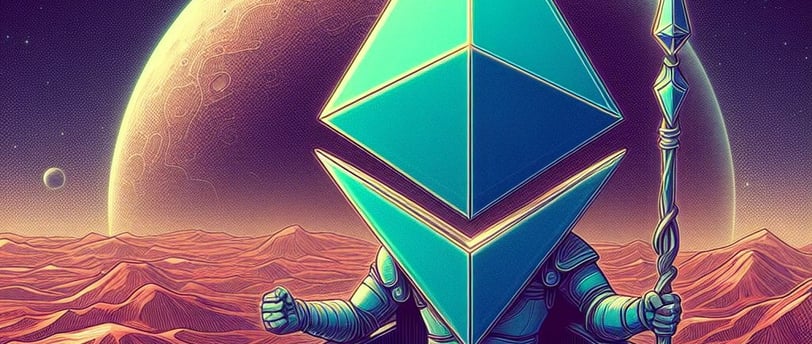Exploring Ethereum's ERC Standards: ERC-20, ERC-721, ERC-1155
Dive into the transformative impact of Ethereum's ERC standards on the blockchain ecosystem, including ERC-20's role in DeFi, ERC-721's influence on NFTs, and ERC-1155's versatility. Explore their applications in finance, digital collectibles, and gaming, showcasing the standards' contribution to Ethereum's diversity and innovation.


The Ethereum blockchain has revolutionized the world of decentralized applications (dApps) by introducing a set of standards known as ERC (Ethereum Request for Comments). These standards provide a framework for developers to create and interact with tokens on the Ethereum network, enabling a wide range of applications and use cases. In this article, we will dive into the world of Ethereum's ERC standards, focusing on the most prominent ones such as ERC-20, ERC-721, and ERC-1155.
Understanding ERC Standards
ERC standards are a set of rules and guidelines that define how tokens should behave on the Ethereum blockchain. They ensure interoperability between different tokens and allow developers to create and interact with tokens in a standardized manner. By adhering to these standards, developers can ensure that their tokens can be easily integrated into existing dApps and wallets.
ERC-20: Fungible Tokens
ERC-20 is the most widely adopted standard on the Ethereum blockchain. It defines a set of rules that govern the behavior of fungible tokens. Fungible tokens are interchangeable and have identical values. For example, if you have two ERC-20 tokens of the same type, they can be exchanged on a one-to-one basis without any differentiation.
ERC-20 tokens have revolutionized the world of decentralized finance (DeFi) by allowing the creation of digital currencies and enabling various financial applications such as lending, borrowing, and decentralized exchanges. Projects like Compound, Aave, and Uniswap have leveraged the ERC-20 standard to create robust DeFi protocols, contributing to the growth of the Ethereum ecosystem.
ERC-721: Non-Fungible Tokens (NFTs)
While ERC-20 tokens represent fungible assets, ERC-721 tokens represent non-fungible assets. Each ERC-721 token is unique and can have distinct properties and attributes. This uniqueness makes ERC-721 tokens ideal for representing digital collectibles, in-game assets, and unique digital assets.
The ERC-721 standard has gained significant attention in recent years with the rise of NFTs. NFTs have revolutionized the art world by enabling artists to tokenize their work and sell it directly to collectors. Platforms like OpenSea and Rarible have leveraged the ERC-721 standard to create marketplaces for digital collectibles, allowing users to buy, sell, and trade unique assets on the Ethereum blockchain.
ERC-1155: Multi-Use Tokens
ERC-1155 is a versatile token standard that combines the features of both ERC-20 and ERC-721. It allows developers to create tokens that can be both fungible and non-fungible, depending on their use case. This flexibility makes ERC-1155 tokens ideal for applications that require both types of tokens.
One of the key advantages of ERC-1155 tokens is their efficiency. Unlike ERC-20 and ERC-721 tokens, which require separate smart contracts for each token type, ERC-1155 tokens can be managed under a single contract. This reduces gas costs and simplifies the development process.
ERC-1155 tokens have found applications in various domains, including gaming, virtual worlds, and decentralized exchanges. They enable the creation of in-game items that can be traded, sold, and used across multiple games, creating a seamless user experience for gamers.
Applications of ERC Standards
The ERC standards have paved the way for the development of a wide range of decentralized applications on the Ethereum blockchain. Let's explore some of the key applications of these standards:
Decentralized Finance (DeFi)
ERC-20 tokens have played a crucial role in the growth of the DeFi ecosystem. DeFi platforms leverage ERC-20 tokens to create decentralized lending and borrowing protocols, automated market makers, and stablecoins. These platforms have brought financial services to the masses by eliminating intermediaries and enabling peer-to-peer transactions.
Projects like MakerDAO have utilized the ERC-20 standard to create DAI, a decentralized stablecoin that maintains its value through an algorithmic mechanism. DAI has become a cornerstone of the DeFi ecosystem, providing stability and liquidity to users.
Digital Collectibles
ERC-721 tokens have revolutionized the world of digital collectibles, enabling artists and creators to tokenize their work and sell it directly to collectors. This has opened up new possibilities for artists, as they can now monetize their digital creations in a secure and transparent manner.
Platforms like CryptoKitties, NBA Top Shot, and Art Blocks have leveraged the ERC-721 standard to create unique digital collectibles that can be bought, sold, and traded on the Ethereum blockchain. These platforms have gained significant popularity, attracting collectors and enthusiasts from around the world.
Gaming and Virtual Worlds
ERC-1155 tokens have found extensive applications in the gaming industry and virtual worlds. They enable the creation of in-game items, virtual land, and digital assets that can be owned, traded, and used across multiple games and platforms.
Platforms like Enjin and Decentraland have leveraged the ERC-1155 standard to create immersive gaming experiences and virtual worlds. Players can own and trade virtual assets, participate in in-game economies, and explore decentralized virtual environments.
Conclusion
The ERC standards have played a pivotal role in the growth and development of the Ethereum ecosystem. From fungible tokens (ERC-20) to non-fungible tokens (ERC-721) and versatile multi-use tokens (ERC-1155), these standards have unlocked a world of possibilities for developers and users alike.
By adhering to these standards, developers can create tokens that are compatible with existing dApps and wallets, facilitating seamless integration and interoperability. The applications of ERC standards span across various domains, including DeFi, digital collectibles, gaming, and virtual worlds, contributing to the diversity and functionality of the Ethereum ecosystem.
As the Ethereum blockchain continues to evolve, we can expect to see further innovations and advancements in the ERC standards, opening up new opportunities for developers and users to explore.
